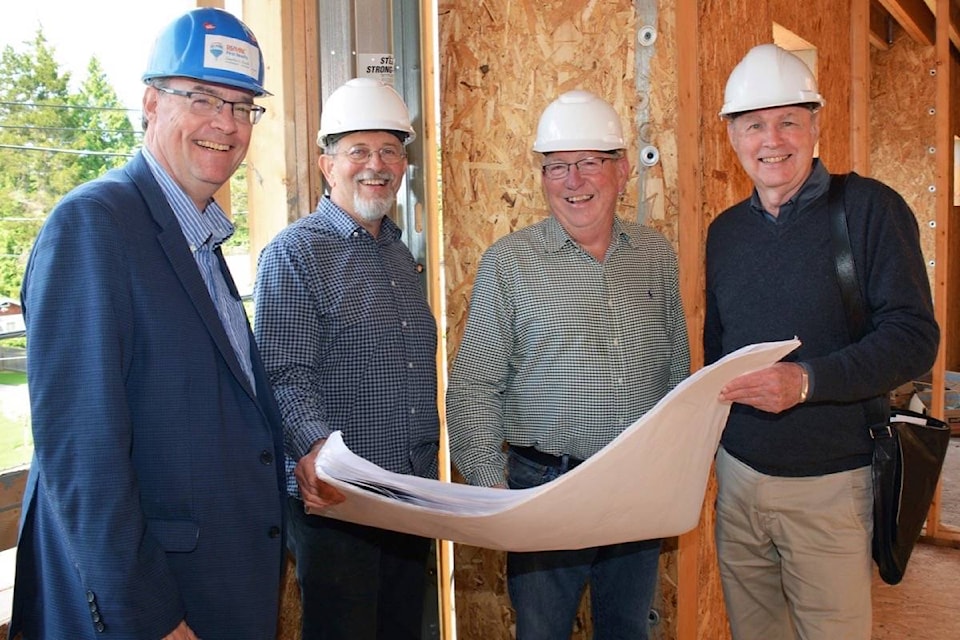Once The 180 is finished in Qualicum Beach, the builder and architect say it will be one of the most sustainable developments in the Parksville Qualicum Beach region.
The 180 on First Avenue in Qualicum Beach, which is currently under construction, will be “among the most environmentally advanced buildings” in the area, according to an information sheet from Lindsay & Associates Real Estate Professionals. The 180 will be a 15-unit strata townhouse development.
According to the informational sheet, the development will include: insulated concrete form foundations; structural insulated panels; double glazed windows; energy efficient heat recovery ventilators; and energy-efficient heat pumps.
Architect Carsten Jensen of Carsten Jensen Architect said The 180 is being built to future building code requirements. Jensen said currently in B.C., the provincial government requires buildings to be built to a standard of EnerGuide 77.
EnerGuide, according to National Resources Canada, is the official mark of the Government of Canada for its energy performance rating and labelling program for key consumer items such as houses, light-duty vehicles and certain energy-using products. EnerGuide works in concert with Canada’s Energy Efficiency Regulations and the Energy Star program that helps to promote energy efficiency in the Canadian marketplace which helps people to save energy, lower utility bills and reduce impact on the environment.
EnerGuide, Jensen said, is not a straightforward assessment though.
“After a building is complete, third-party assessors will come and they’ll do what’s called a blower test,” said Jensen, adding the assessor will look for air leaks.
“Based on what they find, based on the testing that they do, they will assign the dwelling a rating of somewhere between zero and 100. It’s not a straighforward assessment. You can’t say that (an EnerGuide rating of) 40 is twice as good as 20 or that 80 is only slightly better than 70.”
The 180, Jensen said, will be built to what he expects to be a future EnerGuide building code.
“It’s designed to much higher standards — much higher sustainability standards — than is currently required by the current version of the code,” he said. “Our energy modelling people say that it’s going to be somewhere between EnerGuide 83 and 84.”
The EnerGuide 83 or 84 rating, Jensen said, is what he expects the provincial government to be requiring by about 2028.
Jensen said the provincial government has announced that by 2035, it intends to have a code requiring that all buildings in B.C. be built to a standard of EnerGuide 100. He said in order to get there, the code will be upgraded in five steps. The first step, he said, is to follow the current requirements, but prove it; the second step is a minimum EnerGuide rating of 81; the third step is a minimum EnerGuide rating of 84; the fourth step will be a minimum EnerGuide rating of 90-something; and the final step will be EnerGuide 100.
“We figure that step three will come in around 2028, so in about 10 years time, we’ll be required to come up to a rating of around EnerGuide 84. But we are building this not to 2018 standards, but what we project will be 2028 standards.”
Jensen said he doesn’t know if anyone else in the area is building to those types of standards.
Chris Doyle of Doyle Construction is working on The 180, and he said what makes the development different than most in the region is the energy conservation and some of the building systems being used.
“I would say that probably in the neighbourhood of 99.5 per cent of all residential construction in this area is standard wood frame exterior walls,” Doyle said.
The project, he said, has very specific installation methods that involve extensive air sealing and seismic stability that will bring it to an EnerGuide rating of 83 or 84.
He said there are some differences with the sustainability element when it comes to building the development. He said there is some educating for the sub-trade workers that needs to be done “so they don’t go firing holes everywhere.”
“It’s not a very steep learning curve; it’s more about attention to detail. It’s taking that extra couple minutes to do it right rather than just banging it out like you would if you were in a fast-build subdivision type of mode.”
Jensen said he’s been trying to do this work for much of his career.
“But because the building codes haven’t required the higher standards, very few people have been willing to build to the higher standards and so it’s been kind of frustrating.”
Send story tips to: lauren.collins@pqbnews.com
